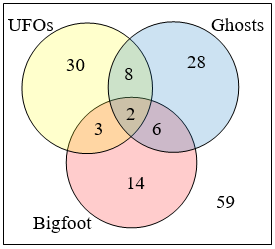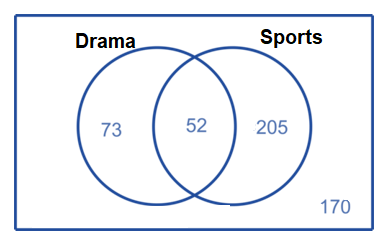1.3: Applications of Sets
- Page ID
- 92949
\( \newcommand{\vecs}[1]{\overset { \scriptstyle \rightharpoonup} {\mathbf{#1}} } \)
\( \newcommand{\vecd}[1]{\overset{-\!-\!\rightharpoonup}{\vphantom{a}\smash {#1}}} \)
\( \newcommand{\id}{\mathrm{id}}\) \( \newcommand{\Span}{\mathrm{span}}\)
( \newcommand{\kernel}{\mathrm{null}\,}\) \( \newcommand{\range}{\mathrm{range}\,}\)
\( \newcommand{\RealPart}{\mathrm{Re}}\) \( \newcommand{\ImaginaryPart}{\mathrm{Im}}\)
\( \newcommand{\Argument}{\mathrm{Arg}}\) \( \newcommand{\norm}[1]{\| #1 \|}\)
\( \newcommand{\inner}[2]{\langle #1, #2 \rangle}\)
\( \newcommand{\Span}{\mathrm{span}}\)
\( \newcommand{\id}{\mathrm{id}}\)
\( \newcommand{\Span}{\mathrm{span}}\)
\( \newcommand{\kernel}{\mathrm{null}\,}\)
\( \newcommand{\range}{\mathrm{range}\,}\)
\( \newcommand{\RealPart}{\mathrm{Re}}\)
\( \newcommand{\ImaginaryPart}{\mathrm{Im}}\)
\( \newcommand{\Argument}{\mathrm{Arg}}\)
\( \newcommand{\norm}[1]{\| #1 \|}\)
\( \newcommand{\inner}[2]{\langle #1, #2 \rangle}\)
\( \newcommand{\Span}{\mathrm{span}}\) \( \newcommand{\AA}{\unicode[.8,0]{x212B}}\)
\( \newcommand{\vectorA}[1]{\vec{#1}} % arrow\)
\( \newcommand{\vectorAt}[1]{\vec{\text{#1}}} % arrow\)
\( \newcommand{\vectorB}[1]{\overset { \scriptstyle \rightharpoonup} {\mathbf{#1}} } \)
\( \newcommand{\vectorC}[1]{\textbf{#1}} \)
\( \newcommand{\vectorD}[1]{\overrightarrow{#1}} \)
\( \newcommand{\vectorDt}[1]{\overrightarrow{\text{#1}}} \)
\( \newcommand{\vectE}[1]{\overset{-\!-\!\rightharpoonup}{\vphantom{a}\smash{\mathbf {#1}}}} \)
\( \newcommand{\vecs}[1]{\overset { \scriptstyle \rightharpoonup} {\mathbf{#1}} } \)
\( \newcommand{\vecd}[1]{\overset{-\!-\!\rightharpoonup}{\vphantom{a}\smash {#1}}} \)
\(\newcommand{\avec}{\mathbf a}\) \(\newcommand{\bvec}{\mathbf b}\) \(\newcommand{\cvec}{\mathbf c}\) \(\newcommand{\dvec}{\mathbf d}\) \(\newcommand{\dtil}{\widetilde{\mathbf d}}\) \(\newcommand{\evec}{\mathbf e}\) \(\newcommand{\fvec}{\mathbf f}\) \(\newcommand{\nvec}{\mathbf n}\) \(\newcommand{\pvec}{\mathbf p}\) \(\newcommand{\qvec}{\mathbf q}\) \(\newcommand{\svec}{\mathbf s}\) \(\newcommand{\tvec}{\mathbf t}\) \(\newcommand{\uvec}{\mathbf u}\) \(\newcommand{\vvec}{\mathbf v}\) \(\newcommand{\wvec}{\mathbf w}\) \(\newcommand{\xvec}{\mathbf x}\) \(\newcommand{\yvec}{\mathbf y}\) \(\newcommand{\zvec}{\mathbf z}\) \(\newcommand{\rvec}{\mathbf r}\) \(\newcommand{\mvec}{\mathbf m}\) \(\newcommand{\zerovec}{\mathbf 0}\) \(\newcommand{\onevec}{\mathbf 1}\) \(\newcommand{\real}{\mathbb R}\) \(\newcommand{\twovec}[2]{\left[\begin{array}{r}#1 \\ #2 \end{array}\right]}\) \(\newcommand{\ctwovec}[2]{\left[\begin{array}{c}#1 \\ #2 \end{array}\right]}\) \(\newcommand{\threevec}[3]{\left[\begin{array}{r}#1 \\ #2 \\ #3 \end{array}\right]}\) \(\newcommand{\cthreevec}[3]{\left[\begin{array}{c}#1 \\ #2 \\ #3 \end{array}\right]}\) \(\newcommand{\fourvec}[4]{\left[\begin{array}{r}#1 \\ #2 \\ #3 \\ #4 \end{array}\right]}\) \(\newcommand{\cfourvec}[4]{\left[\begin{array}{c}#1 \\ #2 \\ #3 \\ #4 \end{array}\right]}\) \(\newcommand{\fivevec}[5]{\left[\begin{array}{r}#1 \\ #2 \\ #3 \\ #4 \\ #5 \\ \end{array}\right]}\) \(\newcommand{\cfivevec}[5]{\left[\begin{array}{c}#1 \\ #2 \\ #3 \\ #4 \\ #5 \\ \end{array}\right]}\) \(\newcommand{\mattwo}[4]{\left[\begin{array}{rr}#1 \amp #2 \\ #3 \amp #4 \\ \end{array}\right]}\) \(\newcommand{\laspan}[1]{\text{Span}\{#1\}}\) \(\newcommand{\bcal}{\cal B}\) \(\newcommand{\ccal}{\cal C}\) \(\newcommand{\scal}{\cal S}\) \(\newcommand{\wcal}{\cal W}\) \(\newcommand{\ecal}{\cal E}\) \(\newcommand{\coords}[2]{\left\{#1\right\}_{#2}}\) \(\newcommand{\gray}[1]{\color{gray}{#1}}\) \(\newcommand{\lgray}[1]{\color{lightgray}{#1}}\) \(\newcommand{\rank}{\operatorname{rank}}\) \(\newcommand{\row}{\text{Row}}\) \(\newcommand{\col}{\text{Col}}\) \(\renewcommand{\row}{\text{Row}}\) \(\newcommand{\nul}{\text{Nul}}\) \(\newcommand{\var}{\text{Var}}\) \(\newcommand{\corr}{\text{corr}}\) \(\newcommand{\len}[1]{\left|#1\right|}\) \(\newcommand{\bbar}{\overline{\bvec}}\) \(\newcommand{\bhat}{\widehat{\bvec}}\) \(\newcommand{\bperp}{\bvec^\perp}\) \(\newcommand{\xhat}{\widehat{\xvec}}\) \(\newcommand{\vhat}{\widehat{\vvec}}\) \(\newcommand{\uhat}{\widehat{\uvec}}\) \(\newcommand{\what}{\widehat{\wvec}}\) \(\newcommand{\Sighat}{\widehat{\Sigma}}\) \(\newcommand{\lt}{<}\) \(\newcommand{\gt}{>}\) \(\newcommand{\amp}{&}\) \(\definecolor{fillinmathshade}{gray}{0.9}\)A Venn diagram is a useful tool in showing the relationship between the actual elements of sets.
Consider the universal set \(U=\{1,2,3,4,5,6,8\}\).
Place the elements in sets \(A=\{3,6,8\}\) and \(B=\{1,2,6,3\}\) in the Venn diagram.

Solution
All elements in the universal set \(U\) must appear in one of the 4 regions labeled I, II, III, and IV. We must decide where each element 1, 2, 3, 4, 5, 6, and 8 go.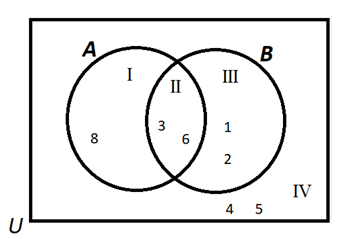
- The element 1 appears in set \(B\) but not in set \(A\). It should be placed in III.
- The element 2 appears in set \(B\) but not in set \(A\). It should be placed in III.
- The element 3 appears in both set \(A\) and in set \(B\). It should be placed in II.
- The elements 4 and 5 appear in neither set \(A\) nor set \(B\). They should be placed in IV.
- The element 6 appears in both set \(A\) and in set \(B\). It should be placed in II.
- The element 8 appears in set \(A\) but not in set \(B\). It should be placed in I.
The completed Venn diagram is shown at the right.
Construct a Venn diagram illustrating the following sets:
\(U=\{a,b,c,d,e,f,g,h,i,j\}\) \(A=\{c,d,e,g,h,i\}\) \(B=\{a,c,d,g\}\) \(C=\{c,f,i,j\}\)
Solution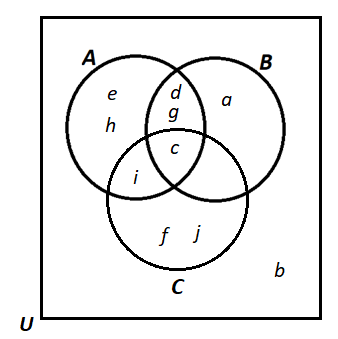
All elements in the universal set \(U\) must appear in one of 8 regions of a three-set Venn diagram.
- The element a belongs to set \(B\) but not to either of the other sets.
- The element b does not belong to any of the 3 sets but it is part of the universal set.
- The element c belongs to all three sets.
- The element d belongs to set \(A\) and set \(B\), but not to set \(C\).
- The element e belongs to set \(A\) but not to either of the other sets.
- The element f belongs to set \(C\) but not to either of the other sets.
- The element g belongs to set \(A\) and set \(B\), but not to set \(C\).
- The element h belongs to set \(A\) but not to either of the other sets.
- The element i belongs to set \(A\) and set \(C\), but not to set \(B\).
- The element j belongs to set \(C\) but not to either of the other sets.
The completed Venn diagram is shown at the right.
Sometimes we may be interested in the cardinality of the union or intersection of sets, but not know the actual elements of each set. This is common in application problems involving surveys.
A survey asks 200 people What beverage do you drink in the morning?, and offers these choices:
- Tea only
- Coffee only
- Both coffee and tea
Suppose 20 report tea only, 80 report coffee only, 40 report both. How many people drink tea in the morning? How many people drink neither tea or coffee?
Solution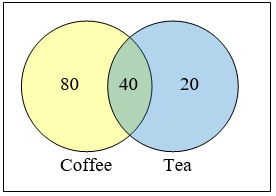
This question can most easily be answered by creating a Venn diagram. We can see that we can find the number of people who drink tea by adding those who drink only tea to those who drink both: 60 people.
We can also see that those who drink neither are those not contained in the any of the three other groupings, so we can count those by subtracting from the cardinality of the universal set, 200:
So we have \(200-20-80-40=60\) people drink neither.
At a school of 500 students, there are 125 students in the drama club, 257 students who play sports, and 52 students who are in the drama club and play sports. Use a Venn diagram to illustrate this information. Then, determine how many students
- play sports but are not in the drama club
- play sports or are in the drama club or both
A survey asks Which online services have you used in the last month?
- Have used both
The results show 40% of those surveyed have used Twitter, 70% have used Facebook, and 20% have used both. How many people have used neither Twitter or Facebook?
Solution
Let \(T\) be the set of all people who have used Twitter and \(F\) be the set of all people who have used Facebook. Notice that while the cardinality of \(F\) is \(70 \%\) and the cardinality of \(T\) is \(40 \%\), the cardinality of \(F \cup T\) is not simply \(70 \%+40 \%\), since that would count those who use both services twice. To find the cardinality of \(F \cup T\), we add the cardinality of \(F\) and the cardinality of \(T\), and then subtract those in intersection that we've counted twice.
In symbols,
\(n(F \cup T)=n(F)+n(T)-n(F \cap T)\)
\(n(F \cup T)=70 \%+40 \%-20 \%\)
\(n(F \cup T)=90 \%\)
Now, to find how many people have not used either service, we're looking for the cardinality of \((F \cup T)^{\prime}\). Since the universal set contains \(100 \%\) of people and the cardinality of \(F \cup T=90 \%\), the cardinality of \((F \cup T)^{\prime}\) must be the other \(10 \%\).
The previous example illustrates two important properties.
\(n(A \cup B)=n(A)+n(B)-n(A \cap B)\)
\(n(A^{\prime})=n(U)-n(A)\)
Notice that the first property can also be written in an equivalent form by solving for the cardinality of the intersection:
\(n(A \cap B)=n(A)+n(B)-n(A \cup B)\)
In a group of 120 students, 35 were enrolled in art class and 57 were enrolled in dance class. There were 12 students who were enrolled in both classes. How many students were enrolled in neither of the classes?
- Answer
-
40
Fifty students were surveyed and asked if they were taking a social science (SS), humanities (HM) or a natural science (NS) course the next quarter.
\(\begin{array}{ll} \text{21 were taking a SS course} & \text{26 were taking a HM course} \\ \text{19 were taking a NS course} & \text{9 were taking SS and HM} \\ \text{7 were taking SS and NS} & \text{10 were taking HM and NS} \\ \text{3 were taking all three} & \text{7 were taking none} \end{array}\)
How many students are taking only a SS course?
Solution
It might help to look at a Venn diagram and complete the cardinality for each of the 8 regions of the diagram. The question here is how many elements are in region \(a\).
diagram. The question here is how many elements are in region \(a\).
From the given data, we know that there are 3 students in region \(e\) and 7 students in region \(h\).
Because 7 students were taking a \(SS\) and \(NS\) course, we know that \(n(d)+n(e)=7\). Since we know there are 3 students in region \(e\), there must be \(7-3=4\) students in region \(d\).
Similarly, since there are 10 students taking \(HM\) and \(NS\), which includes regions \(e\) and \(f\), there must be \(10-3=7\) students in region \(f\).
Since 9 students were taking \(SS\) and \(HM\), there must be \(9-3=6\) students in region \(b\).
Now, we know that 21 students were taking a \(SS\) course. This includes students from regions \(a, b, d,\) and \(e .\) Since we know the number of students in all but region \(a,\) we can determine that \(21-6-4-3=8\) students are in region \(a\).
There are 8 students are taking only a \(SS\) course.
One hundred fifty people were surveyed and asked if they believed in UFOs, ghosts, and Bigfoot.
\(\begin{array}{ll} \text{43 believed in UFOs} & \text{44 believed in ghosts} \\ \text{25 believed in Bigfoot} & \text{10 believed in UFOs and ghosts} \\ \text{8 believed in ghosts and Bigfoot} & \text{5 believed in UFOs and Bigfoot} \\ \text{2 believed in all three} & \text{} \end{array}\)
How many people surveyed believed in none of these things?
- Answer
-
Starting with the intersection of all three circles, we work our way out. Since 10 people believe in UFOs and Ghosts, and 2 believe in all three, that leaves 8 that believe in only UFOs and Ghosts. Continue filling in all the regions. Once the cardinality for each region in the circles is completed, add the cardinalities to get 91 people in the union of all three sets. This leaves \(150-91=59\) people who believe in none.
